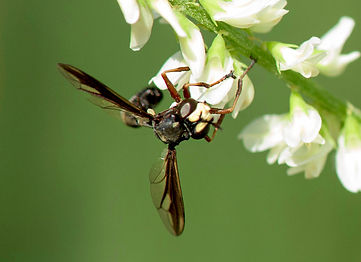
KALYN BICKERMAN-MARTENS
Welcome to my professional site! I'm a Ph.D. candidate at the University of Maine and I study the health of native bumble bees in Maine's wild blueberry fields under the direction of Dr. Frank Drummond.
On this website you'll find information about my research experiences as well as my work in citizen science.
MY RESEARCH AND INTERESTS

A female conopid (Physocephala furcillata) poised to attack (Photo: Holland Havercamp)
Conopid flies are parasitoids that attack foraging bumblebees and lay their eggs inside the bees' abdomens. An infected bee will die within 10-14 days and, at certain times of the year, infection prevalence can be over 60% of bumblebees at a site.
We've been working to rear conopids in the lab from infected bumblebees so that we can identify what species attack Maine bumblebees.

The Maine Bumble Bee Atlas
MBBA is five-year statewide survey of Maine's bumble bee fauna by volunteer citizen scientists coordinated by the Maine Department of Inland Fisheries and Wildlife and the University of Maine. I am one of the coordinators of MBBA and assist in volunteer training, education, and outreach and social media.
A video detailing research done in the Drummond Lab with Eric Venturini, MS., discussing his work on pollinator strips to enhance pollination. A summary of my work begins at 6:50 and details a pesticide trial performed in the summers of 2013 and 2014.
This video was created and published by extension.org in their Bee Health division.
Bumble bees and Neonicotinoids
Another research interest of mine focuses on the effects of the commonly used neonicotinoid pesticide, imidacloprid, on bumble bee colonies.

